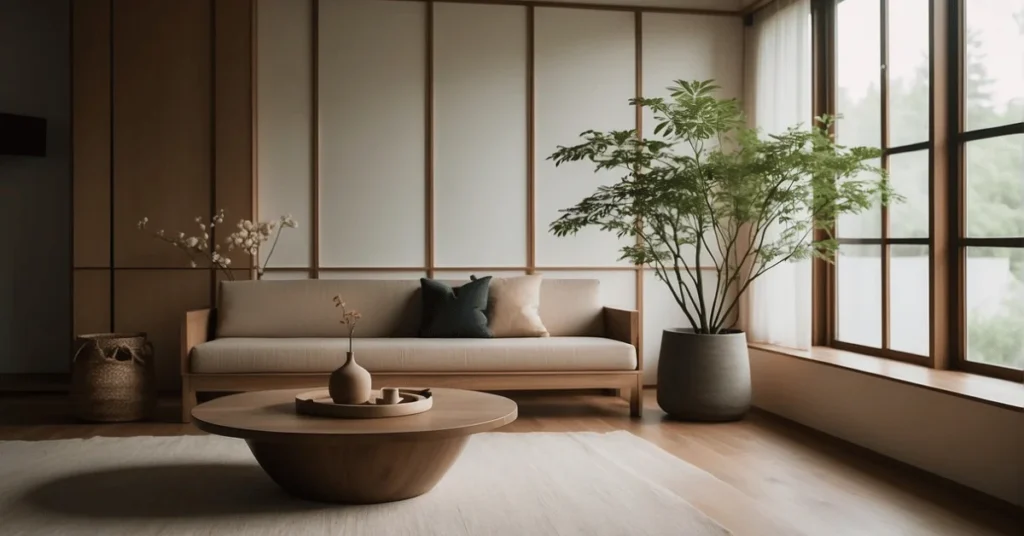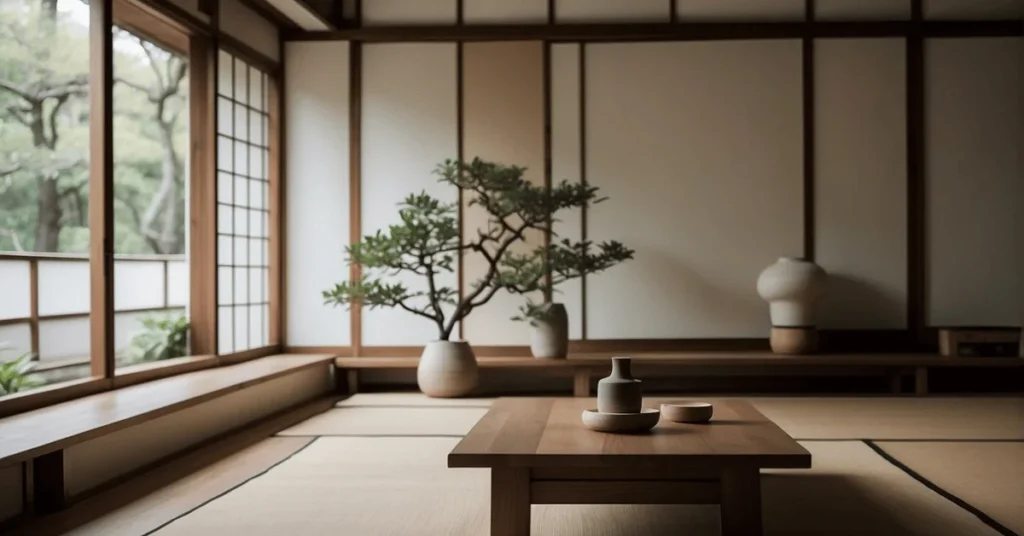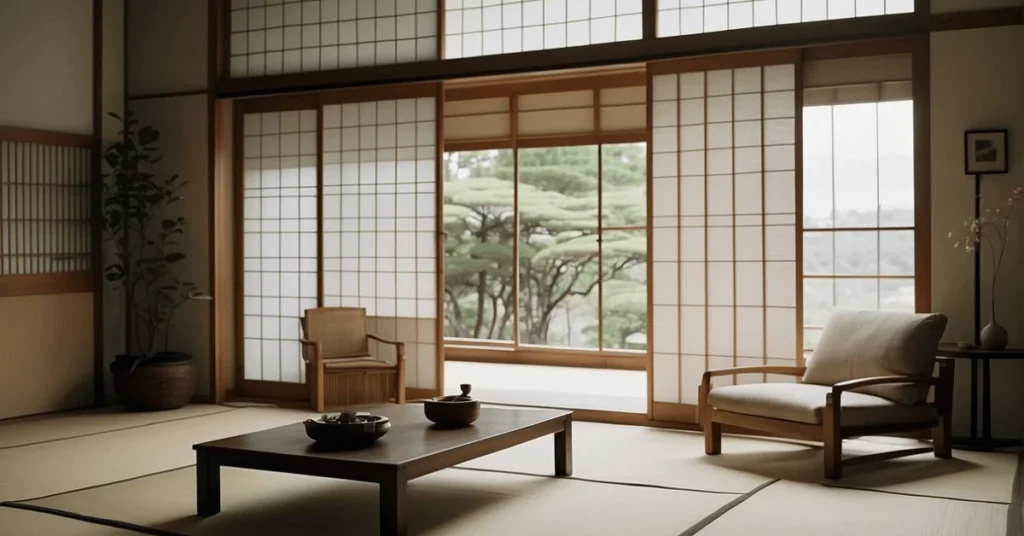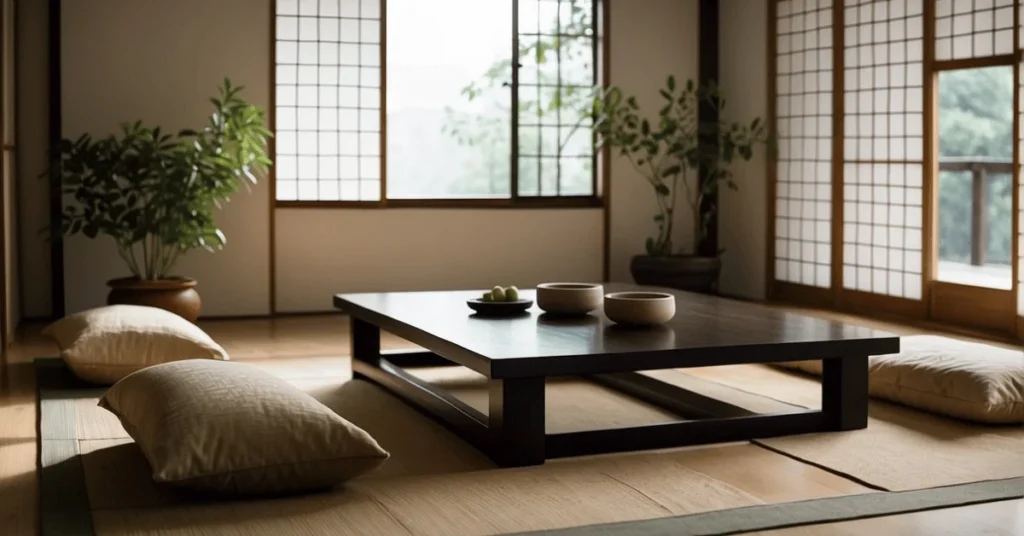We live in a world constantly seeking tranquility and simplicity, and Japanese minimalist interior design offers just that.
It’s an aesthetic that champions purity and the precise use of space, reflecting the minimalist mindset deeply rooted in Japanese culture. In our homes, we often find solace in serene environments; spaces that are not just visually appealing but also spiritually calming. The minimalist style creates such an environment, prioritizing what is essential and finding beauty in simplicity.
This design philosophy extends beyond mere aesthetics; it is a lifestyle deeply intertwined with Japanese traditions. Incorporating elements of nature and practicing restraint in decoration leads to interiors that feel spacious and peaceful.
It’s not just about having fewer items, but about the deliberate choices that enhance the quality of our living spaces. Each element of design in a Japanese minimalist home serves a purpose, whether it’s a piece of furniture or a subtle decor element—nothing is superfluous.
Key Takeaways
- Japanese minimalist interior design fosters simplicity and tranquility in living spaces.
- Essential elements and nature are pivotal to creating serene and purposeful environments.
- Mindful choices in design and decoration define the minimalist aesthetic.
Principles of Japanese Minimalism
Japanese minimalism is not just a design choice; it’s a deliberate way of life that reflects the intrinsic values of Japanese culture. By intertwining simple aesthetics with deep-rooted philosophical tenets, we unveil an environment that radiates tranquility and intentional living.
Influence of Japanese Culture and Nature
Japanese minimalism draws heavily on the country’s love for nature and cultural ideologies. Nature isn’t just an occasional accent; it’s an integral part of the design, introducing elements like natural light and open spaces to blur the lines between indoors and out. Embracing shizen, or naturalness, we infuse our spaces with materials such as wood, bamboo, and stone, which not only look beautiful but also promote a sustainable lifestyle in harmony with our surroundings.
Simplicity and Minimalist Aesthetic
A minimalist aesthetic thrives on the principle of kanso, translating to simplicity or elimination of clutter. This aesthetic is not about stripping away at random but rather a thoughtful reduction to the essentials that bring joy and purpose to our lives. By choosing furnishings and decor that embody simplicity and elegance, we create an uncluttered environment that stands as a testament to quality over quantity.
Functional Space and Storage Solutions
Every element within our minimalist setting serves a purpose, allowing for both beauty and functionality. Innovative storage solutions play a key role, allowing us to maintain an uncluttered living space. Rooms are often multifunctional, with furniture pieces that can be transformed or tucked away when not in use. This commitment to practicality ensures that even the most compact of spaces in Japan are utilized to their fullest, creating environments that breathe with serene practicality.
Key Design Elements of Japanese Minimalist Interior Design

We recognize that creating a serene space relies on several key design principles, and in Japanese minimalist interior design, the emphasis is on a select range of key design elements. These elements not only showcase the beauty and philosophy of Japanese aesthetics but also merge form with function in a harmonious blend.
Natural Materials and Textures
Wood and stone are fundamental to bringing in natural beauty and warmth. The grain of the wood is often left exposed, celebrating its natural state, whereas stone adds a sense of calm solidity. Washi paper and rice paper are also used in shoji screens, which diffuse natural light and create a soft, tranquil atmosphere.
Light and Transparency
Maximizing natural light is essential; it’s about capturing the delicate interplay of light and shadow. Glass panels and Shoji screens allow light to pass through while maintaining privacy, embodying a minimalist approach where every element serves a purpose.
Furniture and Decor
In Japanese minimalist interior design, furnishings are minimal and deliberate. Furniture lines are clean and functional, often echoing the simplicity found in Scandinavian style; this is known as Japandi. Décor is sparse yet impactful, featuring maybe a single vase of flowers or a smooth marble sculpture that draws the eye. Balance and proportion are key, with each piece of furniture or decor chosen not just for its look but for its ability to enhance the overall sense of harmony in the room.
Iconic Japanese Minimalist Projects

In exploring iconic Japanese minimalist interior design projects, we enter a world where the essence of zen marries modern design to create serene living spaces. Here, architecture is more than a mere backdrop for daily life; it’s an integral component of tranquility and aesthetic simplicity. Let’s dive into the architectural marvels and the minds behind them that have come to define this style.
Notable Architecture and Interior Spaces
Tokyo, the heart of Japan, has witnessed the rise of architectural masterpieces that embody minimalism. Spaces like Kinuta Terrace, crafted by Keiji Ashizawa Design in collaboration with Norm Architects, reverberate with a love for Danish design, allowing clean lines and natural materials to speak volumes.
Karimoku Case Study, a beacon of Japanese craftsmanship, harmonizes the relationship between fine woodwork and contemporary design, as seen in their renovation of a Tokyo apartment that now exudes a calm and serene atmosphere.
Prominent Designers and Architectural Firms
Among those sculpting Japan’s minimalist landscape, Keiji Ashizawa Design stands out, merging the functional with the visually stunning, often with a nod to Scandinavian aesthetics.
In parallel, the furniture brand Ariake has formed alliances to foster minimalist spaces, lending their philosophies of simplicity and honest materials to the architectural sphere. These entities don’t merely erect buildings; they curate experiences crafted from the very soul of minimalism, where every structure and space is a serene retreat from the bustling world outside.
Incorporating Japanese Minimalist Design

When we think of Japanese interior design, there’s an instant image of serenity and simplicity that comes to mind. Our approach must respect the deep-rooted aesthetics of minimalism, where every element serves a purpose, evoking tranquility and mindful living.
Adapting to Different Spaces
In adapting Japanese minimalist design to various spaces, sliding doors and interior walls play a crucial role in creating fluid, open environments that can also be intimate when required. The versatility of these elements allows us to transform spaces easily, catering to different needs without clutter. The use of greenery adds a soft touch of nature, seamlessly blending the indoors with the outdoors. This connection with nature is not just about aesthetics; it symbolically promotes a sense of peace and balance within our living spaces.
Combining with Other Design Influences
The beauty of Japanese minimalist design is its ability to harmonize with other styles, such as Scandinavian design. This blend, often referred to as ‘Japandi’, marries the wabi-sabi philosophy of embracing imperfection with Scandinavian practicality. During Stockholm Design Week, we saw a prominent display of this synergy, where craftsmanship and natural materials took center stage. In cities like London and Copenhagen, prominent design firms like Daytrip have eloquently combined the use of artisanal ceramics and fabrics with geometric shapes to create spaces that feel both grounded and modern, while maintaining a minimalist ethos.
Frequently Asked Questions

When we explore the serene world of Japanese minimalism, we’re embracing a philosophy that marries simplicity with natural beauty. Our home becomes a retreat, a place where every element serves a purpose and fosters tranquility. Let’s answer some common inquiries that arise when one aspires to encapsulate this harmonious aesthetic in their living spaces.
How can I incorporate the principles of Japanese minimalism into my home design?
Embodying Japanese minimalism begins with decluttering and choosing furniture that reflects simplicity and function. Incorporate natural materials such as wood and stone to foster a connection with nature, and lean towards a neutral color palette to maintain a calm atmosphere.
What are some key elements of a Japanese minimalist interior designs for living rooms?
A living room influenced by Japanese minimalism features clean lines, open spaces, and a balance between empty spaces and furniture. Integrating elements like tatami mats, low-profile furniture, and natural fiber textiles can enhance the minimalist aesthetic.
In what ways does the Japanese minimalist interior design approach influence bedroom design?
Minimalist bedrooms often include sliding doors or shoji screens, platform beds, and soft lighting to create a Zen-like environment. The design prioritizes open space over excessive decoration, aiming to create a peaceful area conducive to rest.
What characteristics define the exterior design of a Japanese minimalist home?
The exterior of a Japanese minimalist home is typically characterized by its simplicity, with an emphasis on geometric forms and natural materials. The landscape is often designed to reflect the same Zen principles seen inside, using elements like rock gardens and water features to harmonize with the building’s architecture.
Could you name some influential Japanese minimalist interior designs known for their minimalist work?
Designers like Tadao Ando and Shigeru Ban have made significant contributions to minimalist architecture and interior design. Their work often showcases how minimalist principles can be both functional and profoundly beautiful.
How does the concept of Wabi-Sabi manifest in Japanese minimalist interior design?
Wabi-Sabi, an essential principle in Japanese minimalist interior design, finds beauty in imperfection and transience. In interior design, it’s reflected through the use of materials and objects that are raw or show signs of wear, embracing flaws and the natural aging process.
We’ve delved into the serene world of Japanese minimalist interior design, but we’re eager to hear from you! Have personal insights or unique touches that enhance your minimalist space? Share them with us in the comments below!


